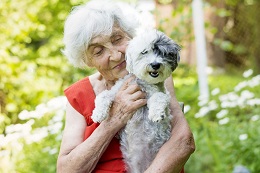
A growing demand for pet-friendly aged care accommodation is backed by scientific evidence demonstrating the health benefits of companion animals, according to a University of South Australia researcher.
Dr Janette Young, a UniSA lecturer in Health Sciences, has made a formal submission to the Royal Commission into Aged Care Quality and Safety, calling for a greater acceptance of animals in aged care settings.
"While 64 per cent of Australian households have a pet, a 2018 Animal Welfare League report found that only 18 per cent of residential aged care facilities allowed residents to live with a pet," Dr Young says. "This is despite all the evidence showing how important the human-animal bond is to people, perhaps even more so as they age."
Almost one in two people over the age of 65 have pets, but many choose to stop keeping them as they age because of fears surrounding who will look after their pets in the event of illness or death.
"Indeed, older pet owners can be forced to either relinquish their pets to family members, animal welfare bodies or euthanise them in the event of entering aged care.
"It is distressing enough having to leave their home and move into aged care but leaving a pet behind - or ending its life due to circumstances beyond their control - only magnifies this stress," Dr Young says.
"While many aged care homes do provide regular contact with animals - in the form of visiting therapy animals - this ignores the unique bond between an individual and an animal who knows them, loves them and accepts them unequivocally."
Dr Young's own research has revealed that for some older people, pets have even stopped them from taking their own life.
The value of pets for people with chronic mental illnesses and physical disabilities is well documented. Multiple studies have also found positive links between pets, health and ageing, include improved wellbeing, companionship, a sense of purpose, increased social interaction, physical activity and independence.
"There's growing global evidence of the negative health impacts of loneliness, including a shorter life span. Pets can help fill this void - often more so than trying to create human social support networks which can be forced.
"From an economic perspective, there are also potential health savings in allowing pets in aged care settings. Happier residents cut both pharmaceutical costs and staff time (in managing poor behaviour). In turn, these savings could be used to fund animal carers."
Dr Young says more research is needed on how to incorporate pets into aged care settings without overburdening staff and considering pet allergies, as well as the needs of all residents.
"In some cases, it is not suitable for pets to be taken into aged care accommodation, especially when their owner can no longer care for themselves, let alone an animal. Not all animals will be suitable or happy in that setting either."
Dr Young is also calling for emergency and short-term animal care services for the pets of older people who are admitted to hospital at short notice.
"This would reduce the stress for older people who are worried about their pet's welfare, often compounding their own health problems."
Additional notes
Dr Janette Young's research is focused on human-animal interactions, exploring the relationships between pets and human mental health, pets and older people, and most recently the intersection of pets, disability and assistance animals. She is a former social worker in the aged care sector and also Co-Chair of Animal Therapies Ltd, a charity connecting people in need with animal-assisted services.
The Animal Welfare League Australia released a 2018 report, "Pets in Aged Care Snapshot," reviewing pet-friendliness among residential and in-home care providers.






